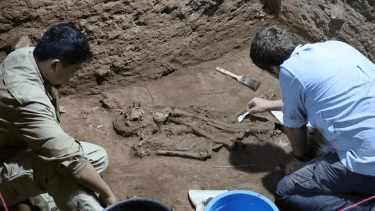Investigating the earliest known stone-age surgery

Sponsored by

It has long been accepted that it was only with the arrival of agricultural life some 10,000 years ago that humans first started performing complex surgeries to aid recovery from injury and illness. Prior to that, hunter-gatherer communities were thought to have relied on rudimentary and relatively ineffective treatments.
That’s all changing, thanks to an expedition by Indonesian and Australian archaeologists, co-led by Griffith University academics. The team travelled to Liang Tebo, a limestone cave in the remote Sangkulirang-Mangkalihat region of eastern Kalimantan, the Indonesian portion of Borneo, which is accessible only by boat at certain times of the year. There, they unearthed the skeletal remains of an adult hunter-gatherer, who—to the archaeologists’ surprise—was missing their entire lower left leg.
Analysis by Dr Melandri Vlok, a University of Sydney palaeopathologist revealed tell-tale bony growths related to healing, suggesting that the limb had not only been removed surgically, but successfully as well, when the individual was still a pre-teen.
‘It was a huge surprise that this ancient forager survived a very serious and life-threatening childhood operation, that the wound healed to form a stump, and that they then lived for years in mountainous terrain with altered mobility—suggesting a high degree of community care,’ Dr Vlok said.
Through radiocarbon analysis of the surrounding sediment, the remains were dated to a staggering 31,000 years ago. This was confirmed by Associate Professor Renaud Joannes-Boyau, Head of the Geoarchaeology and Archaeometry Research Group at Southern Cross University, who measured the amount of radiation received by the tooth enamel during burial.
This vastly predates the previously oldest known evidence of surgical amputation—that of a 7,000-year-old skeleton of an elderly male stone-age farmer from France, whose left forearm was carefully removed just above the elbow.
‘In light of the much younger age of these prior findings, the discovery of a 31,000-year-old amputee in Borneo clearly has major implications for our understanding of the history of Medicine,’ Griffith researcher Dr Tim Maloney said.
‘It was thought that the shift from foraging to farming at the end of the ice age gave rise to previously unknown health problems that stimulated the first incremental advances in medical technology, including the earliest attempts at stone-age surgery,’ said Dr Maloney.
‘What the new finding in Borneo demonstrates is that humans already had the ability to successfully amputate diseased or damaged limbs long before we began farming and living in permanent settlements,’ said Professor Maxime Aubert from the Griffith University Centre for Social and Cultural Research and co-leader of the expedition.
It remains an open question whether the Borneo find is simply the first known evidence medical cultures that were much more widespread, or if the foraging communities inhabiting Borneo 31,000 years ago had acquired an advanced degree of proficiency in this area.
Griffith News Story: https://news.griffith.edu.au/2022/09/08/researchers-discover-earliest-known-stone-age-surgery/